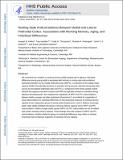| dc.contributor.author | Hedden, Trey | |
| dc.contributor.author | Thompson, Todd W. | |
| dc.contributor.author | Keller, Joseph Barrington | |
| dc.contributor.author | Anteraper, Sheeba Arnold | |
| dc.contributor.author | Gabrieli, John D. E. | |
| dc.contributor.author | Gabrieli, Susan | |
| dc.date.accessioned | 2016-05-09T14:52:52Z | |
| dc.date.available | 2016-05-09T14:52:52Z | |
| dc.date.issued | 2014-12 | |
| dc.date.submitted | 2014-10 | |
| dc.identifier.issn | 00109452 | |
| dc.identifier.uri | http://hdl.handle.net/1721.1/102428 | |
| dc.description.abstract | We examined how variation in working memory (WM) capacity due to aging or individual differences among young adults is associated with intrinsic or resting-state anticorrelations, particularly between (1) the medial prefrontal cortex (MPFC), a component of the default-mode network (DMN) that typically decreases in activation during external, attention-demanding tasks, and (2) the dorsolateral prefrontal cortex (DLPFC), a component of the fronto-parietal control network that supports executive functions and WM and typically increases in activation during attention-demanding tasks. We compared the magnitudes of MPFC-DLPFC anticorrelations between healthy younger and older participants (Experiment 1) and related the magnitudes of these anticorrelations to individual differences on two behavioral measures of WM capacity in two independent groups of young adults (Experiments 1 and 2). Relative to younger adults, older adults exhibited reductions in WM capacity and in MPFC-DLPFC anticorrelations. Within younger adults, greater MPFC-DLPFC anticorrelation at rest correlated with greater WM capacity. These findings show that variation in MPFC-DLPFC anticorrelations, whether related to aging or to individual differences, may reflect an intrinsic functional brain architecture supportive of WM capacity. | en_US |
| dc.description.sponsorship | National Institutes of Health (U.S.) (National Institute on Aging Grant R21 AG030770) | en_US |
| dc.description.sponsorship | National Institutes of Health (U.S.) (Grant T32 GM007484) | en_US |
| dc.description.sponsorship | Barbara J. Weedon Fund Fellowship | en_US |
| dc.language.iso | en_US | |
| dc.publisher | Elsevier | en_US |
| dc.relation.isversionof | http://dx.doi.org/10.1016/j.cortex.2014.12.001 | en_US |
| dc.rights | Creative Commons Attribution-NonCommercial-NoDerivs License | en_US |
| dc.rights.uri | http://creativecommons.org/licenses/by-nc-nd/4.0/ | en_US |
| dc.source | PMC | en_US |
| dc.title | Resting-state anticorrelations between medial and lateral prefrontal cortex: Association with working memory, aging, and individual differences | en_US |
| dc.type | Article | en_US |
| dc.identifier.citation | Keller, Joseph B., Trey Hedden, Todd W. Thompson, Sheeba A. Anteraper, John D.E. Gabrieli, and Susan Whitfield-Gabrieli. “Resting-State Anticorrelations Between Medial and Lateral Prefrontal Cortex: Association with Working Memory, Aging, and Individual Differences.” Cortex 64 (March 2015): 271–280. | en_US |
| dc.contributor.department | Massachusetts Institute of Technology. Department of Brain and Cognitive Sciences | en_US |
| dc.contributor.department | McGovern Institute for Brain Research at MIT | en_US |
| dc.contributor.mitauthor | Keller, Joseph Barrington | en_US |
| dc.contributor.mitauthor | Thompson, Todd W. | en_US |
| dc.contributor.mitauthor | Anteraper, Sheeba Arnold | en_US |
| dc.contributor.mitauthor | Gabrieli, John D. E. | en_US |
| dc.contributor.mitauthor | Gabrieli, Susan | en_US |
| dc.relation.journal | Cortex | en_US |
| dc.eprint.version | Author's final manuscript | en_US |
| dc.type.uri | http://purl.org/eprint/type/JournalArticle | en_US |
| eprint.status | http://purl.org/eprint/status/PeerReviewed | en_US |
| dspace.orderedauthors | Keller, Joseph B.; Hedden, Trey; Thompson, Todd W.; Anteraper, Sheeba A.; Gabrieli, John D.E.; Whitfield-Gabrieli, Susan | en_US |
| dc.identifier.orcid | https://orcid.org/0000-0003-1158-5692 | |
| dc.identifier.orcid | https://orcid.org/0000-0002-1918-0932 | |
| mit.license | PUBLISHER_CC | en_US |
